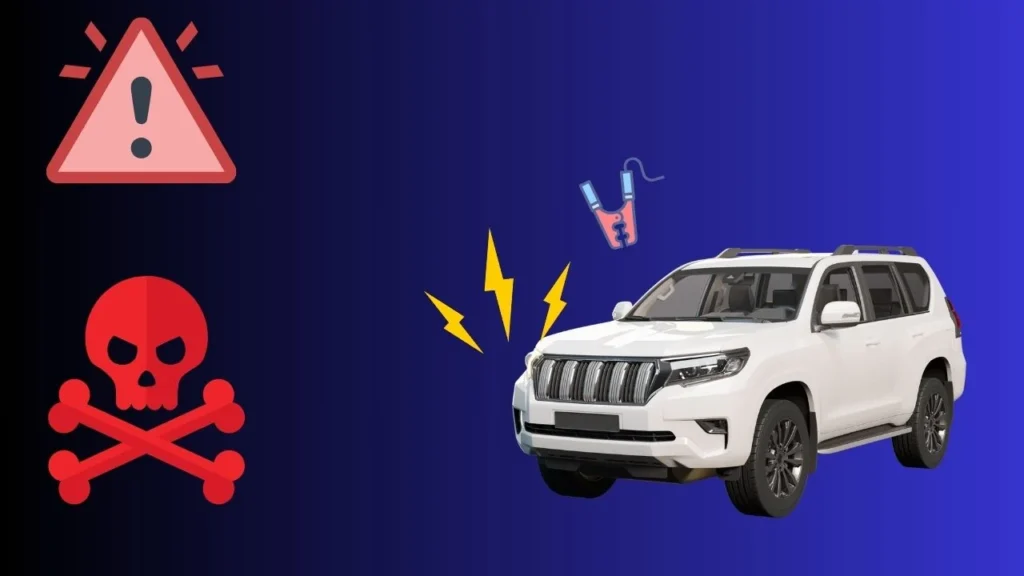Yes, buddy! Ever wondered, can you jump start a car without a battery? It’s something that crosses your mind when you’re stuck on the road with a dead battery and no jumper cables in sight. I’ve been there feeling frustrated and wishing there was an easy fix.
In this post, we’ll dive into whether it’s actually possible to jump-start a car without a battery and what you can do in such situations. If you’re unsure about which type of jump starter works best for different scenarios, check out our detailed comparison of lead-acid vs. lithium-ion jump starters (source). Let’s get into it and clear up the confusion!
Quick Look
No, a car won’t start without a battery since it powers the ignition and electrical system. A jump starter only boosts a weak battery, not a missing one. If your battery is gone, the only solution is to install a new one. For a step-by-step guide on jump-starting a car, check out How to Jump Start a Car with a Dead Battery in 8 Easy Steps.
What is Jump Starting a Car?

Jump-starting a car means using an external power source to start a dead battery. This is done by transferring 12 volts from another battery or a jump starter to crank the engine. Without this boost, the car won’t start. If you’re looking for a reliable jump starter, make sure to read Why Your Car Won’t Jump Start But the Lights Are On: 6 Causes for more insights.
Here’s what you need for a proper jump-start:
- Jumper cables – at least 10 feet long for easy reach.
- A charged battery or jump starter – should have 12.6 volts when fully charged.
- Correct cable connection – red to positive (+), black to negative (-).
- Charging time – wait 5-10 minutes before attempting to start.
- Running time – keep the car running for 20-30 minutes to recharge the battery.
Can You Jump Start a Car Without a Battery?

Alright, boys, let’s get straight to the point. Can you really jump-start a car without a battery? The short answer no, not really. But let’s break it down so you understand why. For a detailed guide, check out Safe Methods for Jump Starting a Honda Pilot.
1. A Car Needs a Battery to Start
Your car’s battery isn’t just there for decoration it powers up everything when you turn the key (or press the start button). The battery provides the initial electric spark to start the engine. Without it, your car is just a hunk of metal that won’t go anywhere.
2. The Alternator Can’t Do It Alone
Some people think, “Well, the alternator generates electricity, so can’t it just power the car directly?” Nope! The alternator only works after the engine is running. It charges the battery and powers other systems, but it can’t start the car by itself.
3. No Battery Means No Electrical Circuit
Even if you connect jumper cables directly to another car, the missing battery creates a gap in the circuit. Most modern cars need at least 12.6 volts from a battery to start. No battery, no complete circuit so nothing happens.
4. Old-School Cars Were Different
Now, if this were the 1970s, you might have had a shot. Some older cars with carbureted engines and simple wiring could, in rare cases, run directly from an external power source. But today’s cars are packed with computers, sensors, and electronics all of which need a functioning battery to operate.
5. What Happens If You Try?
If you attempt to jump-start without a battery, you might hear a tiny spark when you connect the cables, but the engine won’t crank. Even worse, you could damage your car’s electrical system if you mess with the wiring. Your dashboard lights, fuel pump, and ignition system all rely on battery power, so nothing will function properly. With a Most Efficient Lithium-Ion Jump Starter, you’ll have the reliable power boost you need.
Alternatives to Jump-Starting a Car Without a Battery

Alright, buddy, so you’re stuck with a car that has no battery, and you’re wondering if there’s a way to bring it back to life. Let’s be real starting a car without a battery isn’t a walk in the park, but there are a few alternative tricks that might help in emergencies. Car Starts with a Jump but the Battery Is Fine for some tips on troubleshooting this issue.
1. Using a Portable Jump Starter (Battery Pack)
If you don’t have a car battery, a portable jump starter can be a lifesaver. These power packs hold enough charge to kick-start your engine without needing another car. The best part? They’re small, rechargeable, and can be kept in your trunk. Some heavy-duty models pack around 1000+ peak amps, making them reliable even for commercial use. Check out the reliable jump starter for commercial use that can help you get your vehicle started when you need it most.
2. Push-Starting (For Manual Transmission Cars Only)
If you drive a manual transmission, you’re in luck! The push-start method (also called bump-starting) lets you fire up the engine without a battery. Here’s how:
- Get a couple of buddies to push your car (or do it yourself on a slope).
- Shift to 2nd gear, turn the key to the ON position.
- Once the car gains speed (about 5-10 mph), quickly release the clutch.
- If done right, the engine should start up!
This trick won’t work on automatics, so if you’re driving one, keep reading.
3. Using a Jump Box (External Power Source)
A jump box is like a jump starter but stronger. It provides a temporary power source to crank the engine, just like a regular car battery. Some high-end jump boxes have a 12V output and can hold a charge for months. If you’re someone who drives long distances, having one in your trunk is a smart move.
4. Calling Roadside Assistance
If none of these options work, your best bet is to call for help. Roadside assistance services, like AAA or local mechanics, have professional jump-start tools. Most services arrive in 30-60 minutes, so while it’s not instant, it’s still better than being stranded for hours.
5. Swapping in a Spare Battery
If you have access to another car battery, even an old one, you can temporarily connect it just to start your engine. Once the car is running, the alternator should keep it going, but don’t turn off the engine until you reach a repair shop.
Risks and Considerations

Alright buddy, let’s get real about the risks of trying to jump-start a car without a battery. It’s not as simple as it sounds, and messing with your car’s electrical system can lead to costly repairs. Here are five major things you need to think about before attempting anything risky. If your car won’t jump-start but the lights come on, check out this guide on what to do next to troubleshoot the issue properly.
1. Serious Safety Issues
Trying to power up a car without a battery can be straight-up dangerous. Car batteries help regulate voltage, so without one, there’s nothing to control the electrical flow. If you connect an external power source directly, you could end up with sparks, short circuits, or even an electrical fire. And bro, trust me, a fire under the hood is the last thing you want.
2. High Risk of Electrical Damage
Your car’s electrical system is designed to work with a battery. If you try hooking up jumper cables or a power source without it, you’re putting serious stress on delicate components like the alternator, starter motor, and ECU (Engine Control Unit). Once these parts are damaged, they can mess up the entire system, leading to expensive repairs and unnecessary headaches.
3. Engine Won’t Stay Running
Even if you somehow manage to get the engine started, it won’t run for long. The battery provides stability to the alternator, and without it, your car’s electronics might shut down completely. You could end up stranded in the middle of nowhere, and bro, that’s a headache nobody wants.
4. Legal and Warranty Issues
Some modern vehicles have strict guidelines when it comes to their electrical systems. Tampering with the battery setup could void your warranty, meaning you’ll have to pay out of pocket for any damage. Also, in some places, removing the car battery while trying to operate the vehicle is actually illegal. Not worth the trouble, right?
5. Better Alternatives Exist
Instead of taking unnecessary risks, it’s better to keep a portable jump starter in your car or regularly check your battery’s condition. Most car batteries last 3 to 5 years, so replacing them on time can save you from situations like this. Also, push-starting can work for manual cars, but for automatics, you’ll need a proper jump-start method.
Conclusion
Can you jump start a car without a battery? Nope, that won’t work. Your car needs at least one working battery to power up the starter and ignition. Even if you try jumper cables or a jump box, they can’t replace the battery itself.
If the battery is missing, the only real fix is getting a new one. A portable jump starter helps when the battery is weak, not when it’s gone. Since most batteries last 3 to 5 years, checking yours regularly can save you a headache. Stay prepared keep a jump starter and don’t ignore battery health!
FAQs
Q1. Can you jump start a car without a battery?
No, a car cannot be jump-started without a battery. A jump start only works when a weak battery is still in place to complete the circuit. If the battery is missing, you’ll need to install a new one before the car can start.
Q2. What happens if you try to start a car without a battery?
If there’s no battery, the electrical system won’t function, and the engine won’t turn over. The battery is essential for powering the starter motor, ignition system, and fuel injectors.
Q3. Can a portable jump starter start a car without a battery?
No, a portable jump starter is designed to boost a weak battery, not replace a missing one. The battery must be present for the car to start and run properly.
Q4. How long does a car battery last before it needs replacement?
Most car batteries last 3 to 5 years, depending on usage and climate conditions. Regular battery checks and maintenance help prevent unexpected failures.




